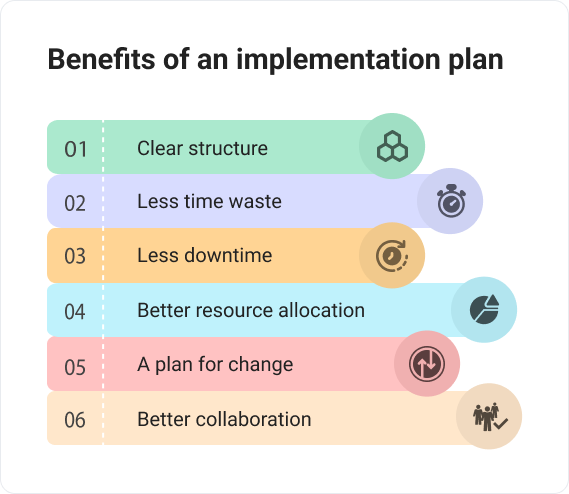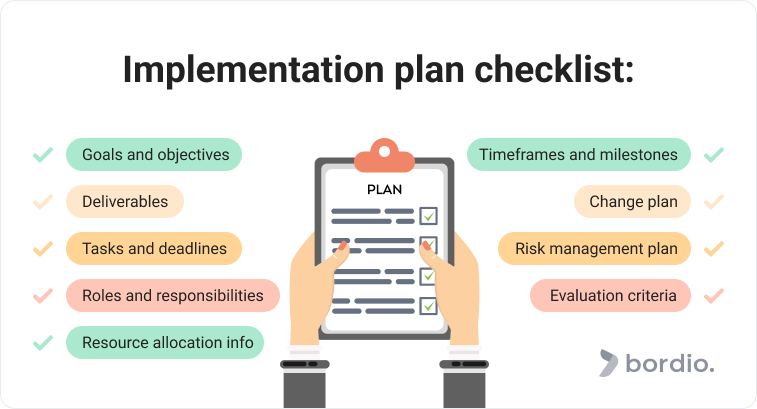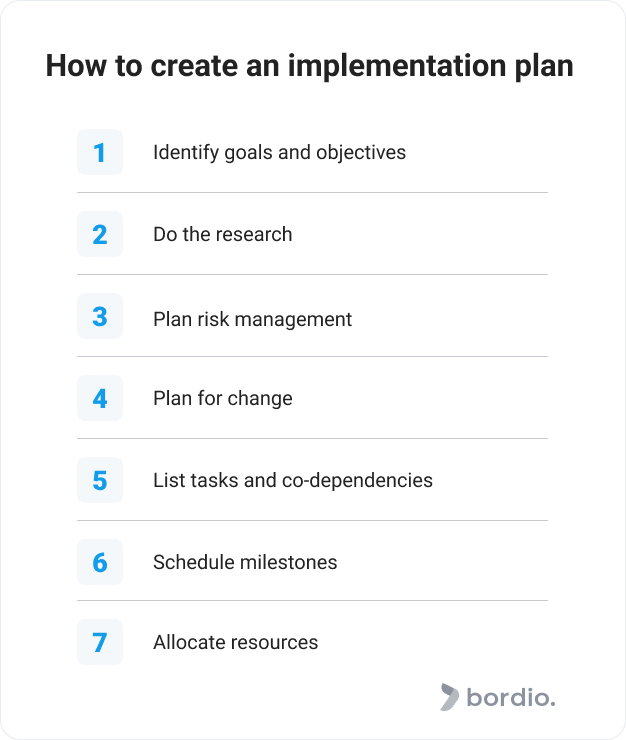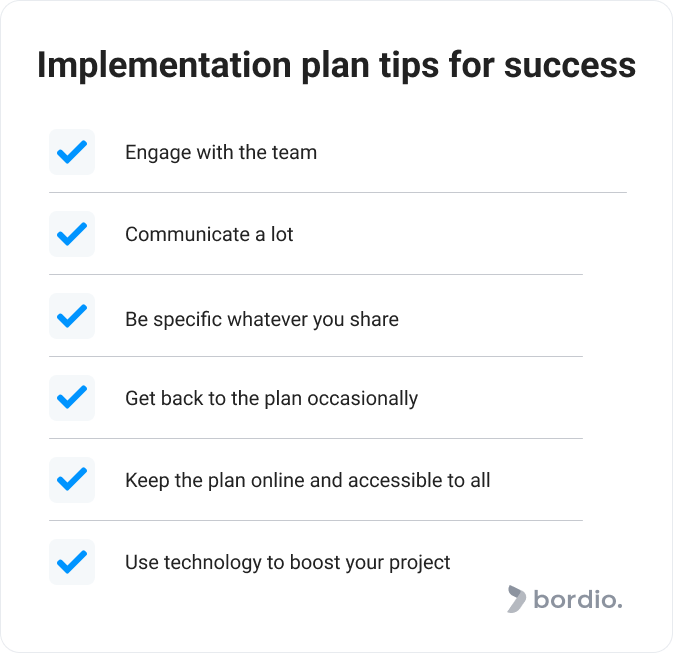Projects are created based on the strategic plan of the company. They support the strategy that stakeholders have defined and help get closer to the ultimate goal.
But in order to get to the goals, a project must be implemented correctly and in a way that aligns with the businesses’ values and ethics. To help with that, project managers design implementation plans for their projects, so that they can bring them to life in the best and most efficient way possible.
Today we will talk about the main benefits, components, and tips for successful planning of the implementation plan using online task organization tools.
What is a project implementation plan?
A project implementation plan is also known as a strategic plan. Essentially, it is a step-by-step guideline that:
- Helps the project team identify what needs to be done and in what order to get to the desired outcome, allowing them to work with their daily planners and task tracking apps efficiently.
- Considers all variables that influence the project plan implementation, like risks and resources.
There is no single format that the strategic implementation plan should come in but it’s usually provided in the form of a Word document or a PowerPoint presentation. A project implementation plan is similar to a business plan, so it is best delivered in a single file where all details and nuances can be described in detail.
An implementation plan is needed for every business initiative to guarantee the best results. Kind of like when you plan a 90-day trip around the world with 30 countries to visit. You will probably still manage without a plan, but you will definitely experience delays, pay more than you initially budgeted for, miss a few countries, and have all sorts of situations along the way.
Why do you need a project implementation plan?
We’ve already mentioned that implementation plans support the project goals and ensure there are no deviations that will cause dissatisfactory project results.
But let’s go into a bit more detail about it and look at the main reasons to add the implementation plan to your project management routine:
- Have a clear structure that you can fall back on. Everything is outlined, including the timeframes, so you just simply follow the instructions.
- You get to think through the tasks in a time planner app and activities in online schedule maker that must be completed, so there is less risk of wasting time on duplicating or busywork.
- There is less downtime associated with figuring out what to do next or waiting on previous tasks to be finished because no one considered co-dependencies.
- Project resource allocation is optimized to the max. You won’t run into an empty pocket three weeks into the project.
- There’s a plan for dealing with change, made in team management tools, so your team can make the most of the changing environment.
- It’s easier to communicate and collaborate on the project. For workers that work online you should use remote team management tool.
In general, the main goal of the implementation plan is to guarantee clarity of who, what, when, and how of the project before it is officially launched.
What does the implementation plan consist of?
A good implementation plan needs to be all-encompassing but also precise and to the point.
Below is what each plan should include:
- List of goals and project objectives. If you’ve done a scope statement before, then include it here as well for more detail and insight, in case somebody wants to dig deeper.
- Project deliverables which are the tangible goals of the project.
- Project tasks with deadlines that will go on the team’s digital to-do lists, you can use online soft for this such as schedule weekly planner for teams.
- Roles and responsibilities within a project (might be less relevant for Lean projects than more formal ones, but makes sense to outline them at least approximately in any case).
- Budget information: how much is available for the entire project.
- Resource allocation information: how are budget, people, time, and other resources allocated across all tasks and goals.
- Timeframes, implementation schedule, and project milestones.
- Change management plan.
- Risk assessment and management plan.
- Evaluation criteria: KPIs and other success metrics, frequency of evaluations (e.g. every week, after each sprint in sprint reviews, once a quarter).
How to create your implementation plan
It’s not a one-size-fits-all situation but there are general tips and tricks that we can recommend to all projects, industries, and methodologies.
An implementation plan is, in some sense, just a fancy-sounding alternative to an action plan.
Step 1: Identify goals and objectives
You can’t get to your destination if you don’t know where it is. Once you know your goals, it will be harder to derail from the original plan and add tasks that don’t generate value.
Talk to stakeholders, ask them questions, and brainstorm together. Then have a meeting with the project team to go through all goals and objectives that you’ve established with the stakeholders. It makes sense to run the goals by the team as they are the ones who will be actively working on the project. They have the expertise and experience, so they’ll quickly point out any incoherence or potential issue.
Talk through the acceptance criteria and KPIs that will be used by stakeholders to approve or decline the project. These things should be written down and have formal approvals from key stakeholders.
Tip: Because you already have the stakeholders’ attention, it might be helpful to touch on potential risks and change management with them. Also, schedule a recurring reminder in your work calendar planner to catch up with stakeholders throughout the project and ensure they’re still on the same page with you.
Step 2: Do your research
We are not talking about market research where you look for clues on whether the project idea is feasible or not. Such issues can be solved for you by saas marketing agency.
Rather we refer to the project-related research. One of the many roles of a project manager is to identify how much time the project will take, how much budget it requires and how many people must be hired to complete the work on time.
Those aspects along with the project scope are known as the project management triangle and they must be estimated precisely to ensure the project will be a success.
Tip: When researching, project managers are recommended to collaborate with the team and stakeholders but also use their previous experience as a reference point. Project management is highly dynamic, and changes occur all the time. Therefore, PMs have the best chance of making correct estimations when they both ask for advice and trust their guts.
Step 3: Brainstorm risks and plan for mitigation
Once the goals are finalized, and the resources requirements with timeline are known, it is time to dig deeper into risk management.
Yes, we know, it’s not fun and you’d rather do something else. However, risk assessment in the early days of the project implementation planning will significantly reduce the chance of failure later on.
A lot of the risks are rather a threat that can be avoided, mitigated, or eliminated if spotted on time. For example, if you are planning for a trip around the world, it makes sense to factor in the risk of having your passport stolen. As a risk mitigation measure, you can keep it separately from your wallet, leave it in the vault in the hotel room, or keep copies with your personal information that you can show in the embassy.
Once you’ve identified all possible risks, use SWOT analysis and Risk Assessment Matrix. These tools are widely spread and easy to use. They will both give you a comprehensive overview of where you are and help identify top risks that you should focus on immediately.
Tip: not all risks are predictable or preventable. Plan for the unforeseen. That means identifying who will be dealing with risks that nobody knew were coming, who they will notify about those risks, and a rough action plan. Also, make sure your project implementation plan is efficient but there is some wiggle room that allows you to pause and deal with an issue without immediately damaging the project’s timeline and everything else.
Step 4: Map out the change management plan
A change management plan helps streamline and standardize the process of dealing with change.
There are 2 types of changes that happen during the project:
- Internal change requests: a stakeholder has a change of heart, something was planned incorrectly initially and has to be adjusted.
- External change: something beyond the company’s control happens and pushes us to change course. Things like competitors launching similar features earlier than us, global pandemics, and economic hardships – all force the project management team to re-think their original goals and plans.
What should the change management plan include?
It’s okay to keep it short and sweet but make sure the key points are included:
- What changes are declined by default.
- How internal change requests are submitted.
- Who reviews the change requests.
- Who implements the change requests.
Once completed, approve the change management plan with key stakeholders and upload it to the team’s project management software so everyone can see it.
Step 5: Create a task list and identify co-dependencies
By now you probably already have a good idea of what tasks and assignments will be included in the project.
In step 5 we finalize the to-do list and make sure it contains everything. Once we have the tasks, we can identify the co-dependencies.
Knowing about task co-dependencies will do several things:
- Will help us plan project execution smarter to avoid needless downtime. Often, projects get delayed because someone needs to wait for another job to be finished. We don’t want that.
- Allow us to schedule tasks in parallel and reduce the project’s timeline. The sooner the product or service is released to the market, the better. If there is a harmless way to speed the process up – why not use it?
- Should something go wrong and the project is delayed, knowing about co-dependencies will help us get it back on track with techniques like Fast-Tracking or crashing.
Step 6: Define and schedule milestones
Project milestones are like checkpoints or metrics that are spread across the project’s timeline. Milestones help us track the progress, look back at what was achieved, and see how well the execution is going.
An example of a milestone in construction can be receiving all permits that are required to start building the house. Or it can be finalizing the plan with the architect.
Milestones can coincide with the end of project phases, like design or implementation in Waterfall, but they can be completely separate. You might add milestones based on your preference and allocate them anywhere you’d like on the project timeline because milestones don’t require time to complete, they just happen.
Tip: Don’t forget to check back with the team members and key project stakeholders. Maybe they’ll come up with cool milestones that will be really meaningful for everyone involved in the project. You can use free daily schedule maker for teams to controll the progress.
Step 7: Allocate resources
The final step of the project implementation plan comprises allocating resources across the project tasks.
Resources include time, money, team members, software, physical equipment, and anything else really. Allocating resources at this point in the project, before it officially kicked off, will serve as an extra safety level. You will see if there are, in fact, enough resources to go by or if you need to re-adjust some things to remain within the budget and the timeline.
If it turns out that there are not enough resources, look for ways to optimize the process and make sure the top priority tasks have enough.
Tip: If you work with project management philosophies like Agile, you might not need to assign team members to tasks right away because they are supposed to be picked up by whoever has the bandwidth and expertise. Naturally, that wouldn’t work with formal methodologies like Prince2. In any case, have a rough estimate or who picks up what to guarantee that you will have enough people to meet the demands of the project.
Common struggles of the implementation plan
It’s not all a bed of roses and, unfortunately, there are known difficulties associated with the implementation plan.
It’s good to be aware of what they are, so you can deal with them or avoid them altogether:
- The risk of not going ahead but rather getting stuck in the planning phase. Know when to stop planning and start doing.
- Stakeholder issues. They might not approve the plan or just not follow it. Stakeholder management is a separate art form. Don’t underestimate their influence on the project as they are known to create all sorts of delays and bottlenecks.
- Not every goal is easily translated into an action step or something measurable. That can become a problem because abstract goals can be interpreted in too many different forms. Techniques like SMART goal planning can help deal with those goals.
- A good plan does not equal project success. You might still fail with a perfectly fine plan, so don’t consider the project implementation plan to be a cure-all.
Implementation plan best practices
Every project manager has their own tricks but here are some of the best practices that have been helping countless PMs across the globe:
- Engage with the team. Ideally find experts in different aspects of the project and include them in strategic planning. It will make your plan as complete and comprehensive as possible.
- Communicate why the implementation plan is being created and how it benefits the entire project team and all stakeholders.
- Be specific with goals/issues/root causes. Less ambiguity – more success.
- Communication is key! Ensure open communication for transparency, and get new creative ideas and participation from others. Create a communications plan for best results.
- Once the implementation plan is written and submitted, don’t forget about it! Go back to the plan to track how well you’re doing and see if your results match the original ideas.
- Keep the implementation plan online and available for anyone to see. It’s good if the team and stakeholders can have an occasional peek into the plan. They can use it for extra motivation, or to check on what’s next and coming. They won’t be bothering the PM for updates too if they can just see what’s planned for next week and what was done this week.
- Use project management software such as Bordio’s best virtual planner to simplify the project implementation process. Automation is your friend – you save time, there’s more transparency, and it’s easy to track success and provide reports. And insist on everyone on the team using the digital weekly planner that will keep them aware of the workload and help fight procrastination.
- If your project is not secret or sensitive in some way, you can share the finished implementation plan with an outsider (like someone in the company who has nothing to do with the project). If they can understand its logic and main points, then the plan is good.
Final thoughts on project implementation plan
Implementation is very important because it’s what brings the plan to life. There’s little point in having ambitious goals and plans if they are not put into action.
Make sure you dedicate enough time to planning and working out all the nuances. Remember that planning is never a waste of time. Every minute of planning saves proportionally much more time in execution.
Also, don’t overcook your implementation plan. It needs to be good but don’t be afraid to move on to the execution phase.









